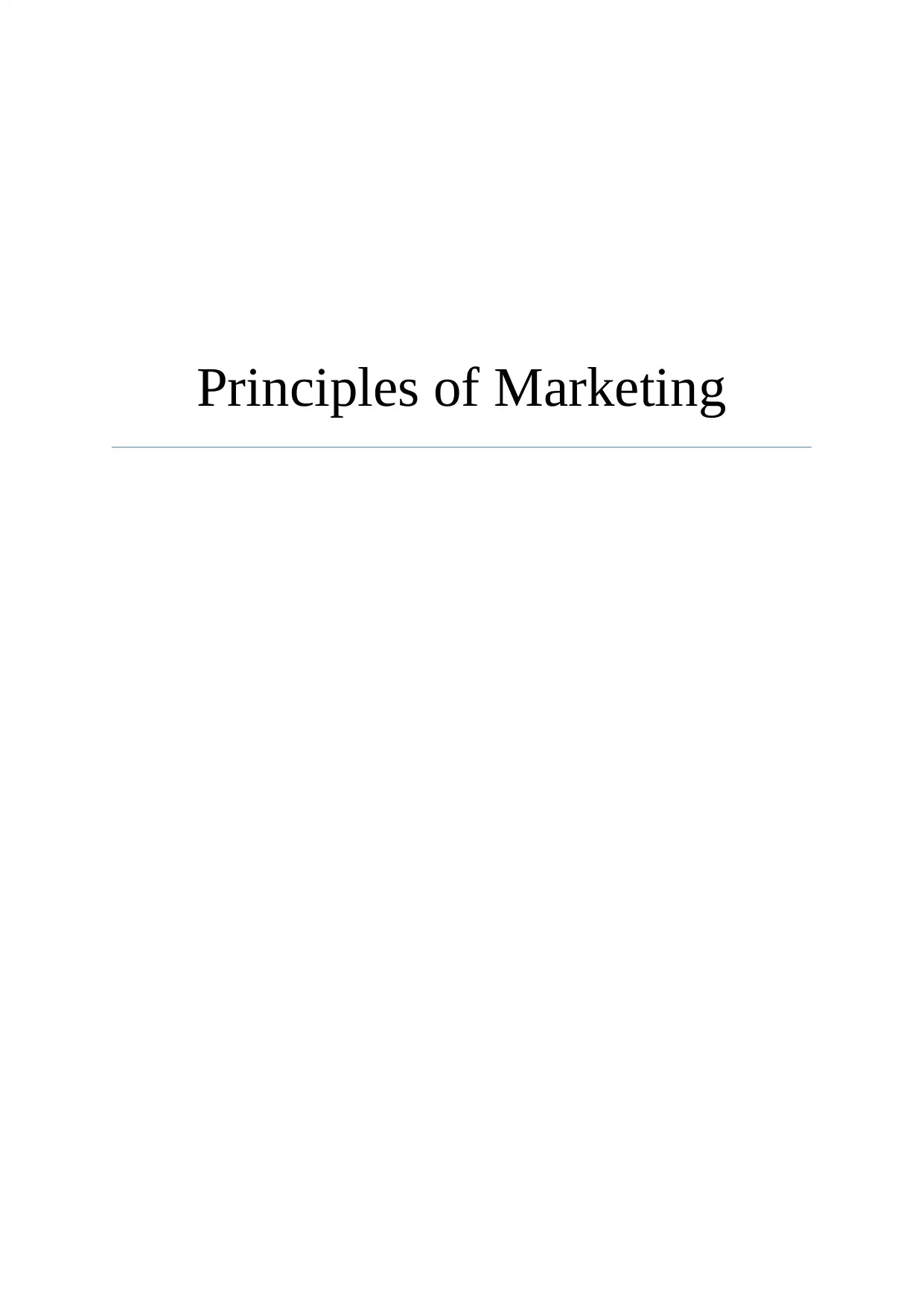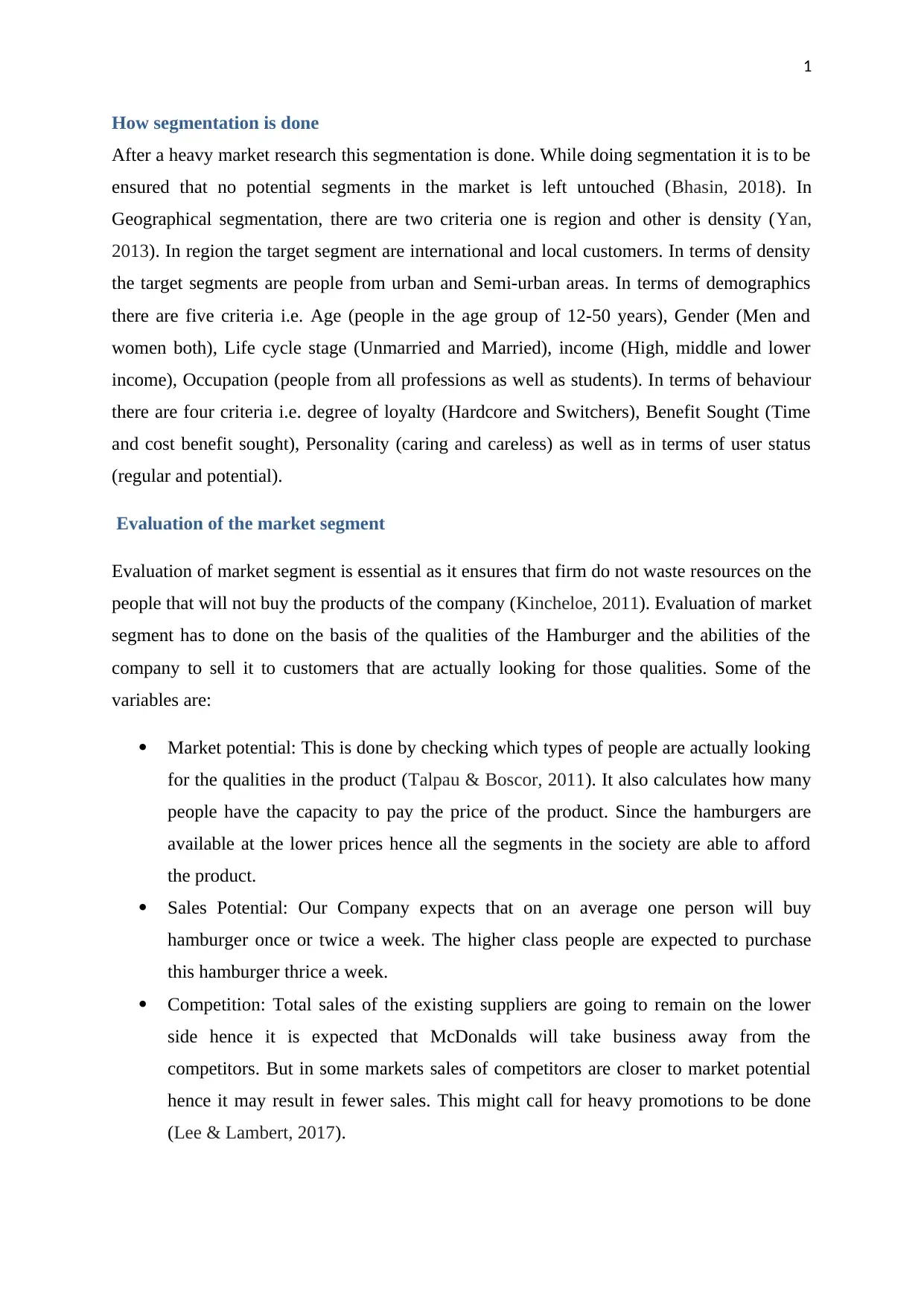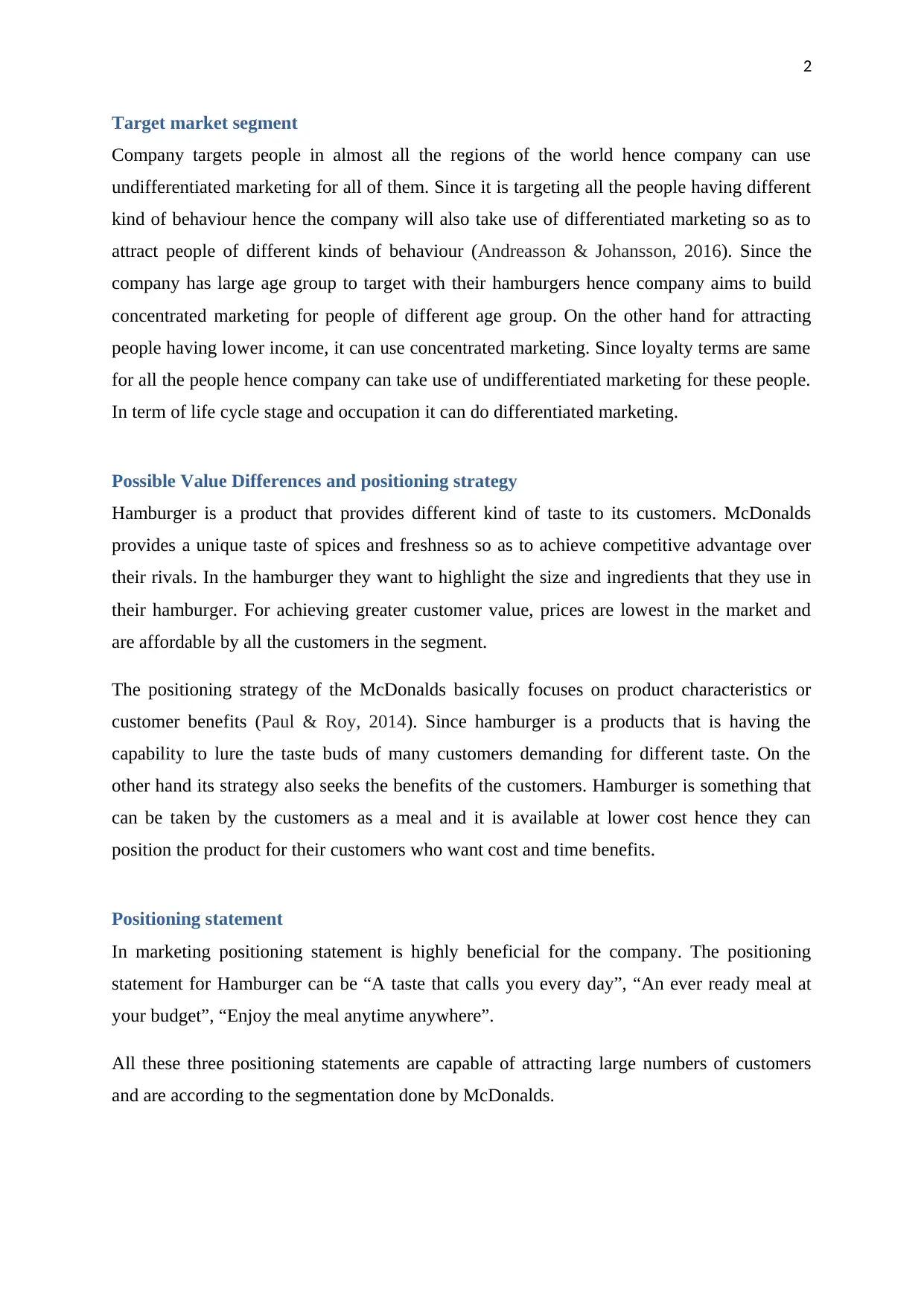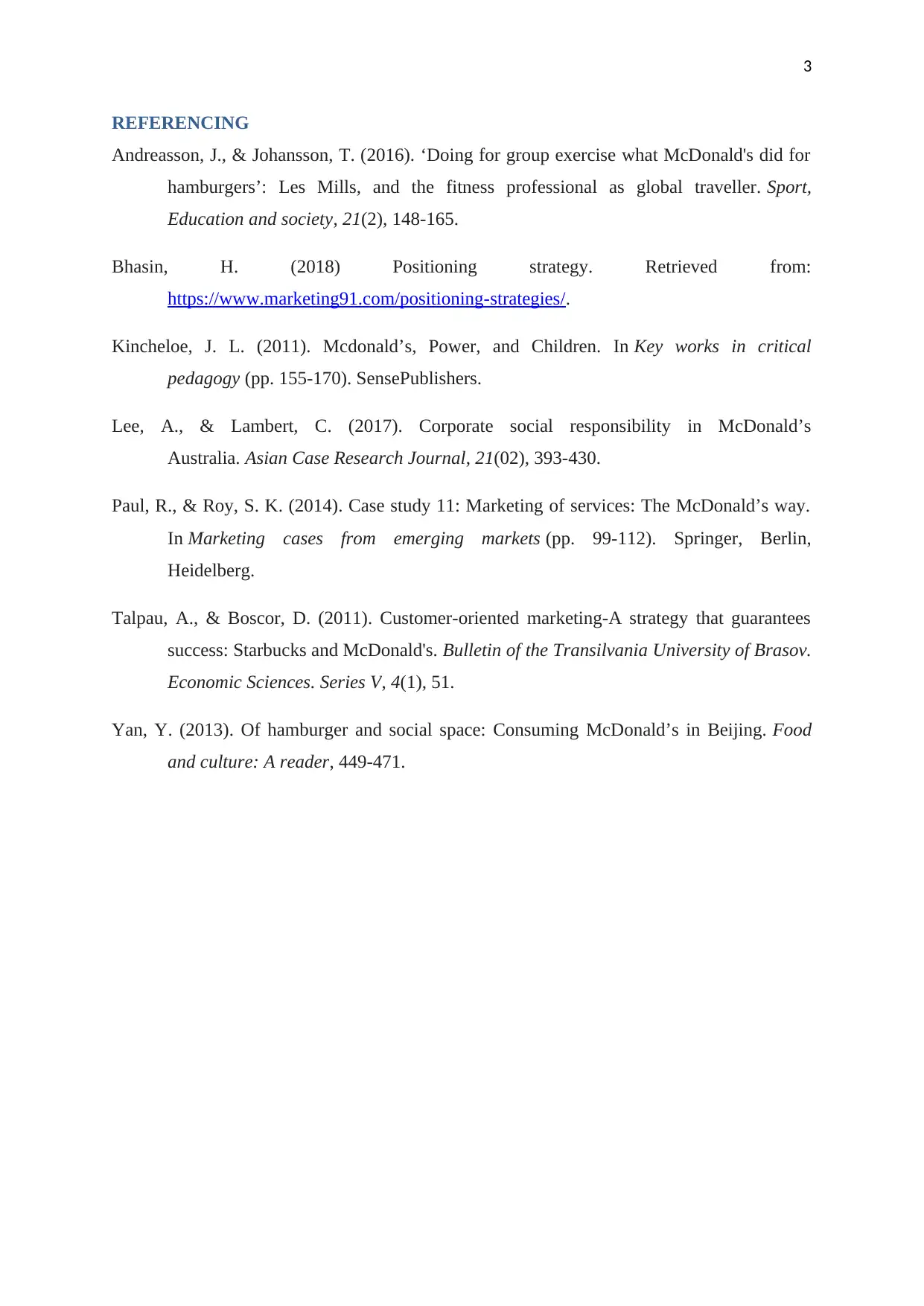TMA 2 BBM 104: Analysis of Hamburger Market Segmentation and Strategy
VerifiedAdded on 2023/06/03
|4
|1093
|460
Homework Assignment
AI Summary
This assignment analyzes the marketing strategies for hamburgers, focusing on market segmentation, evaluation, and targeting. It explores geographical, demographic, and behavioral segmentation approaches, evaluating market potential, sales potential, and competition. The assignment details the selection of target segments, including undifferentiated, differentiated, and concentrated marketing, and identifies value differences and positioning strategies. A positioning statement is designed to attract customers based on taste, affordability, and convenience. The analysis includes references to academic sources, providing a comprehensive overview of marketing principles applied to the hamburger market, specifically referencing McDonald's strategies.

Principles of Marketing
Paraphrase This Document
Need a fresh take? Get an instant paraphrase of this document with our AI Paraphraser

1
How segmentation is done
After a heavy market research this segmentation is done. While doing segmentation it is to be
ensured that no potential segments in the market is left untouched (Bhasin, 2018). In
Geographical segmentation, there are two criteria one is region and other is density (Yan,
2013). In region the target segment are international and local customers. In terms of density
the target segments are people from urban and Semi-urban areas. In terms of demographics
there are five criteria i.e. Age (people in the age group of 12-50 years), Gender (Men and
women both), Life cycle stage (Unmarried and Married), income (High, middle and lower
income), Occupation (people from all professions as well as students). In terms of behaviour
there are four criteria i.e. degree of loyalty (Hardcore and Switchers), Benefit Sought (Time
and cost benefit sought), Personality (caring and careless) as well as in terms of user status
(regular and potential).
Evaluation of the market segment
Evaluation of market segment is essential as it ensures that firm do not waste resources on the
people that will not buy the products of the company (Kincheloe, 2011). Evaluation of market
segment has to done on the basis of the qualities of the Hamburger and the abilities of the
company to sell it to customers that are actually looking for those qualities. Some of the
variables are:
Market potential: This is done by checking which types of people are actually looking
for the qualities in the product (Talpau & Boscor, 2011). It also calculates how many
people have the capacity to pay the price of the product. Since the hamburgers are
available at the lower prices hence all the segments in the society are able to afford
the product.
Sales Potential: Our Company expects that on an average one person will buy
hamburger once or twice a week. The higher class people are expected to purchase
this hamburger thrice a week.
Competition: Total sales of the existing suppliers are going to remain on the lower
side hence it is expected that McDonalds will take business away from the
competitors. But in some markets sales of competitors are closer to market potential
hence it may result in fewer sales. This might call for heavy promotions to be done
(Lee & Lambert, 2017).
How segmentation is done
After a heavy market research this segmentation is done. While doing segmentation it is to be
ensured that no potential segments in the market is left untouched (Bhasin, 2018). In
Geographical segmentation, there are two criteria one is region and other is density (Yan,
2013). In region the target segment are international and local customers. In terms of density
the target segments are people from urban and Semi-urban areas. In terms of demographics
there are five criteria i.e. Age (people in the age group of 12-50 years), Gender (Men and
women both), Life cycle stage (Unmarried and Married), income (High, middle and lower
income), Occupation (people from all professions as well as students). In terms of behaviour
there are four criteria i.e. degree of loyalty (Hardcore and Switchers), Benefit Sought (Time
and cost benefit sought), Personality (caring and careless) as well as in terms of user status
(regular and potential).
Evaluation of the market segment
Evaluation of market segment is essential as it ensures that firm do not waste resources on the
people that will not buy the products of the company (Kincheloe, 2011). Evaluation of market
segment has to done on the basis of the qualities of the Hamburger and the abilities of the
company to sell it to customers that are actually looking for those qualities. Some of the
variables are:
Market potential: This is done by checking which types of people are actually looking
for the qualities in the product (Talpau & Boscor, 2011). It also calculates how many
people have the capacity to pay the price of the product. Since the hamburgers are
available at the lower prices hence all the segments in the society are able to afford
the product.
Sales Potential: Our Company expects that on an average one person will buy
hamburger once or twice a week. The higher class people are expected to purchase
this hamburger thrice a week.
Competition: Total sales of the existing suppliers are going to remain on the lower
side hence it is expected that McDonalds will take business away from the
competitors. But in some markets sales of competitors are closer to market potential
hence it may result in fewer sales. This might call for heavy promotions to be done
(Lee & Lambert, 2017).

2
Target market segment
Company targets people in almost all the regions of the world hence company can use
undifferentiated marketing for all of them. Since it is targeting all the people having different
kind of behaviour hence the company will also take use of differentiated marketing so as to
attract people of different kinds of behaviour (Andreasson & Johansson, 2016). Since the
company has large age group to target with their hamburgers hence company aims to build
concentrated marketing for people of different age group. On the other hand for attracting
people having lower income, it can use concentrated marketing. Since loyalty terms are same
for all the people hence company can take use of undifferentiated marketing for these people.
In term of life cycle stage and occupation it can do differentiated marketing.
Possible Value Differences and positioning strategy
Hamburger is a product that provides different kind of taste to its customers. McDonalds
provides a unique taste of spices and freshness so as to achieve competitive advantage over
their rivals. In the hamburger they want to highlight the size and ingredients that they use in
their hamburger. For achieving greater customer value, prices are lowest in the market and
are affordable by all the customers in the segment.
The positioning strategy of the McDonalds basically focuses on product characteristics or
customer benefits (Paul & Roy, 2014). Since hamburger is a products that is having the
capability to lure the taste buds of many customers demanding for different taste. On the
other hand its strategy also seeks the benefits of the customers. Hamburger is something that
can be taken by the customers as a meal and it is available at lower cost hence they can
position the product for their customers who want cost and time benefits.
Positioning statement
In marketing positioning statement is highly beneficial for the company. The positioning
statement for Hamburger can be “A taste that calls you every day”, “An ever ready meal at
your budget”, “Enjoy the meal anytime anywhere”.
All these three positioning statements are capable of attracting large numbers of customers
and are according to the segmentation done by McDonalds.
Target market segment
Company targets people in almost all the regions of the world hence company can use
undifferentiated marketing for all of them. Since it is targeting all the people having different
kind of behaviour hence the company will also take use of differentiated marketing so as to
attract people of different kinds of behaviour (Andreasson & Johansson, 2016). Since the
company has large age group to target with their hamburgers hence company aims to build
concentrated marketing for people of different age group. On the other hand for attracting
people having lower income, it can use concentrated marketing. Since loyalty terms are same
for all the people hence company can take use of undifferentiated marketing for these people.
In term of life cycle stage and occupation it can do differentiated marketing.
Possible Value Differences and positioning strategy
Hamburger is a product that provides different kind of taste to its customers. McDonalds
provides a unique taste of spices and freshness so as to achieve competitive advantage over
their rivals. In the hamburger they want to highlight the size and ingredients that they use in
their hamburger. For achieving greater customer value, prices are lowest in the market and
are affordable by all the customers in the segment.
The positioning strategy of the McDonalds basically focuses on product characteristics or
customer benefits (Paul & Roy, 2014). Since hamburger is a products that is having the
capability to lure the taste buds of many customers demanding for different taste. On the
other hand its strategy also seeks the benefits of the customers. Hamburger is something that
can be taken by the customers as a meal and it is available at lower cost hence they can
position the product for their customers who want cost and time benefits.
Positioning statement
In marketing positioning statement is highly beneficial for the company. The positioning
statement for Hamburger can be “A taste that calls you every day”, “An ever ready meal at
your budget”, “Enjoy the meal anytime anywhere”.
All these three positioning statements are capable of attracting large numbers of customers
and are according to the segmentation done by McDonalds.
⊘ This is a preview!⊘
Do you want full access?
Subscribe today to unlock all pages.

Trusted by 1+ million students worldwide

3
REFERENCING
Andreasson, J., & Johansson, T. (2016). ‘Doing for group exercise what McDonald's did for
hamburgers’: Les Mills, and the fitness professional as global traveller. Sport,
Education and society, 21(2), 148-165.
Bhasin, H. (2018) Positioning strategy. Retrieved from:
https://www.marketing91.com/positioning-strategies/.
Kincheloe, J. L. (2011). Mcdonald’s, Power, and Children. In Key works in critical
pedagogy (pp. 155-170). SensePublishers.
Lee, A., & Lambert, C. (2017). Corporate social responsibility in McDonald’s
Australia. Asian Case Research Journal, 21(02), 393-430.
Paul, R., & Roy, S. K. (2014). Case study 11: Marketing of services: The McDonald’s way.
In Marketing cases from emerging markets (pp. 99-112). Springer, Berlin,
Heidelberg.
Talpau, A., & Boscor, D. (2011). Customer-oriented marketing-A strategy that guarantees
success: Starbucks and McDonald's. Bulletin of the Transilvania University of Brasov.
Economic Sciences. Series V, 4(1), 51.
Yan, Y. (2013). Of hamburger and social space: Consuming McDonald’s in Beijing. Food
and culture: A reader, 449-471.
REFERENCING
Andreasson, J., & Johansson, T. (2016). ‘Doing for group exercise what McDonald's did for
hamburgers’: Les Mills, and the fitness professional as global traveller. Sport,
Education and society, 21(2), 148-165.
Bhasin, H. (2018) Positioning strategy. Retrieved from:
https://www.marketing91.com/positioning-strategies/.
Kincheloe, J. L. (2011). Mcdonald’s, Power, and Children. In Key works in critical
pedagogy (pp. 155-170). SensePublishers.
Lee, A., & Lambert, C. (2017). Corporate social responsibility in McDonald’s
Australia. Asian Case Research Journal, 21(02), 393-430.
Paul, R., & Roy, S. K. (2014). Case study 11: Marketing of services: The McDonald’s way.
In Marketing cases from emerging markets (pp. 99-112). Springer, Berlin,
Heidelberg.
Talpau, A., & Boscor, D. (2011). Customer-oriented marketing-A strategy that guarantees
success: Starbucks and McDonald's. Bulletin of the Transilvania University of Brasov.
Economic Sciences. Series V, 4(1), 51.
Yan, Y. (2013). Of hamburger and social space: Consuming McDonald’s in Beijing. Food
and culture: A reader, 449-471.
1 out of 4
Related Documents
Your All-in-One AI-Powered Toolkit for Academic Success.
+13062052269
info@desklib.com
Available 24*7 on WhatsApp / Email
![[object Object]](/_next/static/media/star-bottom.7253800d.svg)
Unlock your academic potential
Copyright © 2020–2025 A2Z Services. All Rights Reserved. Developed and managed by ZUCOL.




